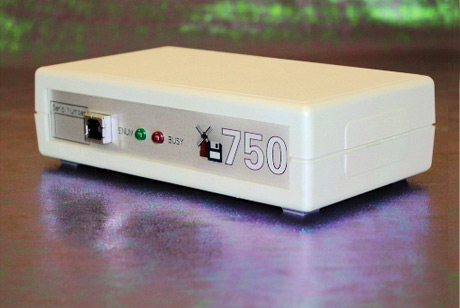Monitor - ISSN 1472-0221
The Newsletter for PC-Based Data Acquisition and Control
Issue 238, June 2018
Welcome to Monitor, the data acquisition newsletter. Any comments or questions email monitor@windmillsoft.com.
You can download this issue as a pdf file from https://www.windmill.co.uk/monitor/monitor238.pdf.
Contents
* Automated passenger counting
* Your Data Acquisition Questions Answered
* Data Acquisition News Round-Up
Automated Passenger Counting
Web link: windmill.co.uk/apc.html
A data acquisition system can automatically count passengers on buses, trains and light rail networks.
There are several methods to do this, but the most accurate and versatile is video passenger counting. These systems log numbers of people getting on and off at each stop or station and are over 98% accurate. Compare this to manual passenger counting where counts are out by an average of 15%1.
Internet-of-Things
Another advantage of such a counting system is that information can be made available in real-time over the Internet-of-Things, often as part of a Smart City setup.

How it Works
Passenger counting works by having a camera over each door. This is linked to a counting unit running a software algorithm which detects entries and exits. An embedded video server lets users view live video footage alongside the people counts, so they can accurately verify, and configure, the system over the internet. Once set up, the counts alone are sent over the network to save bandwidth. Counts can also be stored locally.
Fine-tuning the Video Analytics
The video analytics can be fine-tuned in software during the configuration phase. For example, settings can be adjusted for shadows or poor light. Software also lets users set the time period over which counts are accumulated - down to every 5 minutes.
Occupancy and Location of Public Transport
An automated passenger counting system (APC) provides reliable data at a low cost, no matter how busy the service.
An APC system on its own provides valuable information, but when you add vehicle tracking you can see where a bus or train is as well as how many people are on it.
Validating the Data
With CCTV counting operators can simply watch the video back - which shows both people getting on and off the vehicle together with the increasing counts - and thus verify that the system is counting properly. Transit agencies can thus have complete confidence in the passenger data they are receiving. The passenger count data can be easily integrated into existing database systems.
More Information
For more information on automated passenger counting see the Retail Sensing or Urban Sensing web sites, or contact us.
Your Data Acquisition Questions Answered
Question
"We are looking to run three or four LVDTs and a pressure sensor. The DC version of the LVDT requires an excitation voltage between 8 to 28 V - we will probably look to use around 12 V. The output is either V DC or 4-20 mA. Looking to capture the output of each with time and then to real time plot pressure vs LVDT measured displacement. Would your Microlink 750 do the job?"
Answer
You would be able to monitor the DC Voltage output version of the LVDTs and also a pressure sensor with a similar voltage outuput using a Microlink 750. This could sample at up to a few readings per second. To get a plot of pressure against displacement you would probably need to pass the data into Excel and plot an x-y graph there.

The Microlink 750 costs 150 GBP from our on-line shop at https://www.windmillsoft.com/daqshop/analogue-input.html. Read more about the Microlink 750 and charting with Excel.
DAQ News Round-up
Welcome to our round-up of the data acquisition and control news. If you would like to receive more timely DAQ news updates then follow us on Twitter - @DataAcquisition - or grab our rss feed.
Smart cities technology markets to grow annually by 23% to 2023
With the number of smart cities increasing from about two dozen to more than 100 in just a few years, the market for smart city information and communication technology is anticipating steady growth, according to a report by BCC Research.
Source: Retail Sensing
https://www.retailsensing.com/
What causes the sound of a dripping tap - and how do you stop it?
Using ultra-high-speed cameras and modern audio capture techniques, researchers from the University of Cambridge, found that the "plink, plink" sound produced by a water droplet hitting a liquid surface is caused not by the droplet itself, but by the oscillation of a small bubble of air trapped beneath the water's surface. The bubble forces the water surface itself to vibrate, acting like a piston to drive the airborne sound. To stop it, just add washing-up liquid.
Source: University of Cambridge
https://www.cam.ac.uk/
IEEE adopts OpenFog Reference Architecture as official standard for fog computing
The standard provides industry-accepted framework to enable performance and security while accelerating innovation and market growth in IoT, 5G and AI
Source: IEEE
https://standards.ieee.org/
Engineer creates new design for ultra-thin capacitive sensors
Professor creates a workable sensor with the least possible resistance to motion. The thin and flexible sensor is ideal for sensing sounds because it can move with the airflow made by even the softest noises and addresses issues with accelerometers, microphones and many other similar sensors.
Source: Binghampton University
https://engineering.cmu.edu/
* Copyright Windmill Software Ltd
* Reprinting permitted with this notice included
* For more articles see https://www.windmill.co.uk/
We are happy for you to copy and distribute this
newsletter, and use extracts from it on your own web
site or other publication, providing the above notice
is included and a link back to our website is in place.
For previous issues by subject see https://www.windmill.co.uk/monitorindex.html
SUBSCRIBING OR CANCELLING SUBSCRIPTION Visit https://www.windmill.co.uk/newsletter.html and add or remove your e-mail address.
Windmill Software Ltd, PO Box 58, North District Office,
Manchester, M8 8QR, UK
Telephone: +44 (0)161 834 6688
Facsimile: +44 (0)161 833 2190
E-mail: monitor@windmillsoft.com
https://www.windmill.co.uk/
https://www.windmillsoft.com/
